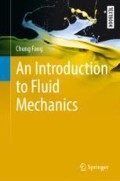Abstract
Dimensional analysis is one of the most important mathematical tools in the study of fluid motion. It is a mathematical technique which makes use of dimensions of physical quantities as an aid to the solutions to many engineering problems. The main advantage of a dimensional analysis of a problem is that it reduces the number of variables by combining dimensional variables to form dimensionless products. Dimensional analysis has been found useful in both analytical and experimental work in the study of fluid mechanics and is closely related to the model similitude which is required for conducting experiments in laboratory. To explore the idea of dimensional analysis and model similitude, the discussion on dimensions and units of physical variables is introduced, followed by the Buckingham theorem and a suggested procedure in conducting dimensional analysis. The mathematical foundations of dimensional analysis and the theory of physical model, specifically the modeling law, are outlined, and the differential equations of fluid motion in dimensional forms are brought to dimensionless forms to illustrate the significant dimensionless products. The physical interpretations of obtained dimensionless products are given to show their influence in achieving a complete model similarity of a physical process.
Access this chapter
Tax calculation will be finalised at checkout
Purchases are for personal use only
Notes
- 1.
The names “dyne” and “erg” were first proposed as the units of force and energy in 1861 by Joseph David Everett, 1831–1904, a British physicist.
- 2.
James Prescott Joule, 1818–1889, a British physicist and mathematician, who discovered the relation between heat and mechanical work , leading to the law of conservation of energy and the development of first law of thermodynamics.
- 3.
James Watt, 1736–1819, a Scottish inventor and mechanical engineer, who improved Thomas Newcomen’s 1712 “Newcomen steam engine” by his “Watt steam engine” in 1781, which was a key part to Industrial Revolution.
- 4.
Edgar Buckingham, 1867–1940, an American physicist, who contributed to the fields of soil physics, gas properties, acoustics, fluid mechanics, and blackbody radiation.
- 5.
John William Strutt, or Lord Rayleigh, 1842–1919, a British physicist, who, together with William Ramsay, earned the Nobel Prize for Physics in 1904 for his contribution to the discovery of argon. Sir William Ramsay, 1852–1916, a British chemist, who discovered the noble gases and received the Nobel Prize in Chemistry in 1904.
- 6.
Theodore von Kármán, 1881–1963, a Hungarian-American mathematician and physicist, who contributed to many key advances in aerodynamics and is recognized as “Father of Aerodynamics.”
- 7.
This was done by Taylor by using a movie film of the nuclear test when Americans were testing their atomic bombs in the Manhattan Project during World War II, although the strength of bomb was kept secret, while the movie film was not classified. Sir Geoffrey Ingram Taylor, 1886–1975, a British physicist and mathematician, who was a major figure in fluid dynamics and wave theory and was described as one of the most notable scientists in the twentieth century.
- 8.
The term “Q.E.D.” is an initialism of the Latin phrase, which reads: “quod erat demonstrandum,” with the translation as “this is what to be proved.”
- 9.
Other scale factors can be defined in a similar manner.
- 10.
William Froude, 1810–1879, a British hydrodynamicist and engineer, who first formulated reliable laws for the resistance that water offers to ships and for predicting their stability.
- 11.
In deriving Eq. (6.4.17), the gravitational constant assumes the same value in both the model and prototype, for the experiments are normally conducted on the earth’s surface.
- 12.
Vincenc Strouhal, 1850–1922, a Czech physicist specializing in experimental physics. Jean Claude Eugène Péclet, 1793–1857, a French physicist.
- 13.
Lewis Fry Richardson, 1881–1953, a British mathematician, physicist and meteorologist, who contributed to the mathematical techniques of weather forecasting.
- 14.
Carl-Gustaf Arvid Rossby, 1898–1957, a Swedish-born American meteorologist, who first explained the large-scale motions of atmosphere in terms of fluid mechanics and identified and characterized both the jet stream and long waves in the westerlies that were later named the Rossby waves . Vagn Walfrid Ekman, 1874–1954, a Swedish oceanographer, who proposed the Ekman spiral to explain the moving trajectory of a moving object in a rotating environment.
Further Reading
E. Buckingham, On physically similar system: illustrations of the use of dimensional equations. Phys. Rev. 4(4), 345–376 (1914)
R.W. Fox, P.J. Pritchard, A.T. McDonald, Introduction to Fluid Mechanics, 7th edn. (Wiley, New York, 2009)
K. Hutter, K. Jönk, Continuum Methods of Physical Modeling (Springer, Berlin, 2004)
K. Hutter, Y. Wang, Fluid and Thermodynamics. Volume 1: Basic Fluid Mechanics (Springer, Berlin, 2016)
D.C. Ispen, Units, Dimensions, and Dimensionless Numbers (McGraw-Hill, New York, 1960)
S.J. Kline, Similitude and Approximation Theory (McGraw-Hill, New York, 1965)
B.S. Massey, Units, Dimensional Analysis and Physical Similarity (Van Nostrand Reinhold Company, London, 1971)
B.R. Munson, D.F. Young, T.H. Okiishi, Fundamentals of Fluid Mechanics, 3rd edn. (Wiley, New York, 1990)
R.H.F. Pao, Fluid Mechanics (Wiley, New York, 1961)
K.I. Sedov, Similarity and Dimensional Methods in Mechanics (Academic Press, New York, 1959)
E.S. Taylor, Dimensional Analysis for Engineers (Clarendon Press, Oxford, 1974)
G.I. Taylor, The formation of a blast wave by a very intensive explosion. Part I: Theoretical discussion, Part II: The atomic explosion of 1945, in Proceeding of Royal Society London A, vol. 201, pp. 159–186, 1945
M.S. Yalin, Theory of Hydraulic Models (Macmillan, London, 1971)
Author information
Authors and Affiliations
Corresponding author
Rights and permissions
Copyright information
© 2019 Springer International Publishing AG
About this chapter
Cite this chapter
Fang, C. (2019). Dimensional Analysis and Model Similitude. In: An Introduction to Fluid Mechanics. Springer Textbooks in Earth Sciences, Geography and Environment. Springer, Cham. https://doi.org/10.1007/978-3-319-91821-1_6
Download citation
DOI: https://doi.org/10.1007/978-3-319-91821-1_6
Published:
Publisher Name: Springer, Cham
Print ISBN: 978-3-319-91820-4
Online ISBN: 978-3-319-91821-1
eBook Packages: Earth and Environmental ScienceEarth and Environmental Science (R0)

